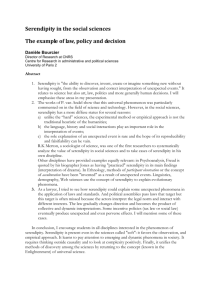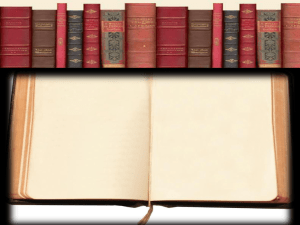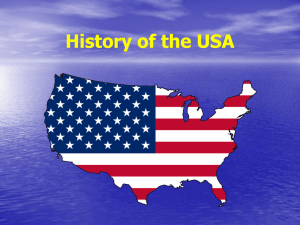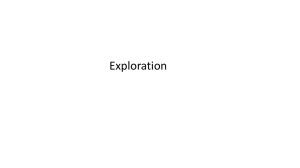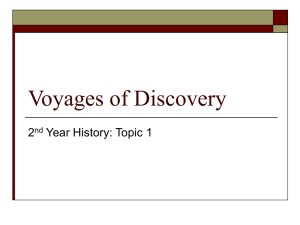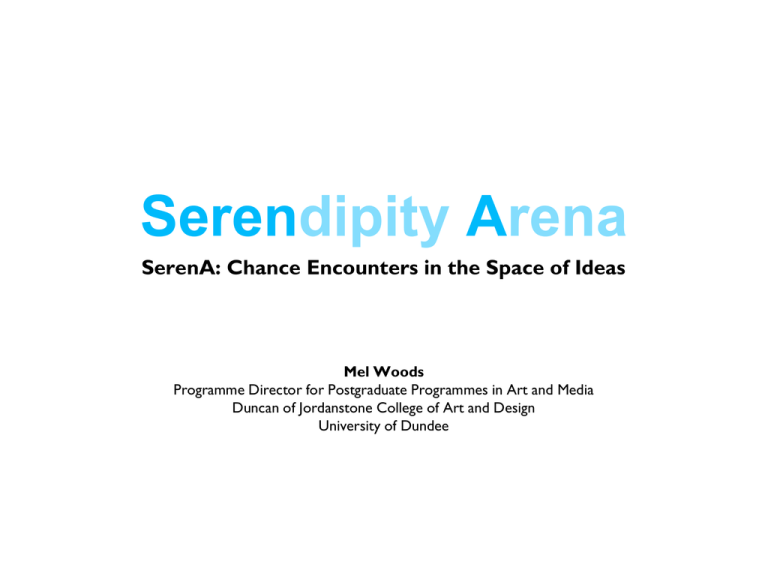
Serendipity Arena
SerenA: Chance Encounters in the Space of Ideas
Mel Woods
Programme Director for Postgraduate Programmes in Art and Media
Duncan of Jordanstone College of Art and Design
University of Dundee
Serendipity Arena
Chance Encounters in the Space of Ideas
A £1.87 million UKRC funded project, which
will investigate serendipity, to deliver new
understanding of the role it plays in research
and innovation in the digital economy.
Serendipity Arena
People
Context
Knowledge and Impact
The future of innovation is ... together
The future of innovation is ... together
The future of innovation is ... together
The future of innovation is ... together
The future of innovation is ... together
The future of innovation is ... together
The future of innovation is ... together
Blue Sky
Thinking
exciting collaborative
free thinkin
interactive
Sandpit
creative environment
Why?
Library Information archive and
categorisation 1950’s
New Research Methods
Greater Collaboration
Multiple formats, mach-up
Creative Theory & creative practice
Importance of ephemerma
Students want to learn in different ways to their teachers
Proliferation of Information
New Technologies
Born Digital
Mass Digital
Rights Management
Information and Media Literacy
Web2.0/3.0
Mobile and Interoperability
Display Technologies
Natural User Interfaces
Growth of the UK Enterpreneurialism & Innovation
Creative Industries
Knowledge Economy Science, Media and Technology
Changes to Researcher Expectations
Want to contact anytime, anywhere
Store, personalise, manipulate, repurpose, share info with peers
New ways of relating to each other and information
Different attitude to Intellectual Property
Global Changes Affecting
the Research Environment
Serendipity
\ser-uhn-DIP-uh-tee\ , noun;
1. The faculty or phenomenon of making fortunate accidental discoveries.
Origin:
The word serendipity was formed by English author Horace Walpole (1717-1797) from
Serendip (also Serendib), an old name for Sri Lanka, in reference to a Persian tale, The Three
Princes of Serendip, whose heroes "discovered, quite unexpectedly, great and wonderful good
in the most unlikely of situations, places and people."
plastic used for making solid objects (the first ones being billiard balls, substituting for expensive ivory).
•Rayon, the first synthetic silk, was discovered by French chemist Hilaire de Chardonnet, an assistant to Louis Pasteur. He spilled a bottle of collodion and found later that he could draw thin strands from the evaporated viscous liquid.
•The possibility of synthesizing indigo, a natural dye extracted from a plant with the same name, was discovered by a chemist named Sapper who was heating coal tar when he accidentally broke a thermometer whose mercury content acted as a catalyst to
produce phthalic anhydride, which could readily be converted into indigo.
•The dye monastral blue was discovered in 1928 in Scotland, when chemist A.G. Dandridge heated a mixture of chemicals at high temperature in a sealed iron container. The iron of the container reacted with the mixture, producing some pigments called
phthalocyanines. By substituting copper for iron he produced an even better pigment called 'monastral blue', which became the basis for many new coloring materials for paints, lacquers and printing inks.
•Acesulfame, an artificial sweetener, was discovered accidentally in 1967 by Karl Claus at Hoechst AG.
•Another sweetener, cyclamate, was discovered by graduate student Michael Sveda, when he smoked a cigarette accidentally contaminated with a compound he had recently synthesized.
•Aspartame (NutraSweet) was accidentally ingested by G.D. Searle & Company chemist James M. Schlatter, who was trying to develop a test for an anti-ulcer drug.
•Saccharin was accidentally discovered during research on coal tar derivatives.
•Saran (plastic) was discovered when Ralph Wiley had trouble washing beakers used in development of a dry cleaning product. It was soon used to make plastic wrap.
•A new blue pigment with almost perfect properties was discovered accidentally by scientists at Oregon State University after heating manganese oxide [7]
Pharmacology
•Penicillin by Alexander Fleming. He failed to disinfect cultures of bacteria when leaving for his vacations, only to find them contaminated with Penicillium molds, which killed the bacteria. However, he had previously done extensive research into antibacterial
substances.
•The psychedelic effects of LSD by Albert Hofmann. A chemist, he unintentionally absorbed a small amount of it upon investigating its properties, and had the first acid trip in history, while cycling to his home in Switzerland; this is commemorated among LSD
users annually as Bicycle Day.
•5-fluorouracil's therapeutic action on actinic keratosis, was initially investigated for its anti-cancer actions
•Minoxidil's action on baldness; originally it was an oral agent for treating hypertension. It was observed that bald patients treated with it grew hair too.
•Viagra (sildenafil citrate), an anti-impotence drug. It was initially studied for use in hypertension and angina pectoris. Phase I clinical trials under the direction of Ian Osterloh suggested that the drug had little effect on angina, but that it could induce marked
penile erections.
•Retin-A anti-wrinkle action. It was a vitamin A derivative first used for treating acne. The accidental result in some older people was a reduction of wrinkles on the face
•The libido-enhancing effect of l-dopa, a drug used for treating Parkinson's disease. Older patients in a sanatorium had their long-lost interest in sex suddenly revived.
•The first benzodiazepine, chlordiazepoxide (Librium) was discovered accidentally in 1954 by the Austrian scientist Dr Leo Sternbach (1908–2005), who found the substance while cleaning up his lab.[citation needed]
•The first anti-psychotic drug, chlorpromazine, was discovered by French pharmacologist Henri Laborit. He wanted to add an anti-histaminic to a pharmacological combination to prevent surgical shock and noticed that patients treated with it were unusually
calm before the operation.
•The anti-cancer drug cisplatin was discovered by Barnett Rosenberg. He wanted to explore what he thought was an inhibitory effect of an electric field on the growth of bacteria. It was rather due to an electrolysis product of the platinum electrode he was
using.
•The anesthetic nitrous oxide (laughing gas). Initially well known for inducing altered behavior (hilarity), its properties were discovered when British chemist Humphry Davy tested the gas on himself and some of his friends, and soon realised that nitrous oxide
considerably dulled the sensation of pain, even if the inhaler was still semi-conscious.
•The anesthetic ether.[citation needed]
•Mustine – a derivative of mustard gas (a chemical weapon), used for the treatment of some forms of cancer. In 1943, physicians noted that the white cell counts of US soldiers, accidentally exposed when a cache of mustard gas shells were bombed in Bari,
Italy, decreased, and mustard gas was investigated as a therapy for Hodgkin's lymphoma.
•The first oral contraceptive (a.k.a. The Pill) was discovered by Dr. Carl Djerassi accidental production of synthetic progesterone and its intentional modification to allow for oral intake.[citation needed]
•Prontosil, an antibiotic of the sulfa group was an azo dye. German chemists at Bayer had the wrong idea that selective chemical stains of bacteria would show specific antibacterial activity. Prontosil had it, but in fact it was due to another substance
metabolised from it in the body, sulfanilimide.
Medicine and Biology
•Bioelectricity, by Luigi Galvani. He was dissecting a frog at a table where he had been conducting experiments with static electricity. His assistant touched an exposed sciatic nerve of the frog with a metal scalpel which had picked up a charge, provoking a
muscle contraction.
•Neural control of blood vessels, by Claude Bernard
•Anaphylaxis, by Charles Richet. When he tried to reuse dogs that had previously shown allergic reactions to sea anemone toxin, the reactions developed much faster and were more severe the second time.
•The role of the pancreas in glucose metabolism, by Oskar Minkowski. Dogs that had their pancreas removed for an unrelated physiological investigation urinated profusely; the urine also attracted flies, signaling its high glucose content.
•Coronary catheterization was discovered as a method when a cardiologist at the Cleveland Clinic accidentally injected radiocontrast into the coronary artery instead of the left ventricle.
•The mydriatic effects of belladonna extracts, by Friedrich Ferdinand Runge
•Interferon, an antiviral factor, was discovered accidentally by two Japanese virologists, Yasu-ichi Nagano and Yasuhiko Kojima while trying to develop an improved vaccine for smallpox.
•The hormone melatonin was discovered in 1917 when it was shown that extract of bovine pineal glands lightened frog skin. In 1958 its chemical structure was defined by Aaron B. Lerner and in the mid-70s it was demonstrated that also in humans the
production of melatonin exhibits and influences a circadian rhythm.
Physics and Astronomy
•Discovery of the planet Uranus by William Herschel. Herschel was looking for comets, and initially identified Uranus as a comet until he noticed the circularity of its orbit and its distance and suggested that it was a planet, the first one discovered since
antiquity.
•Infrared radiation, again by William Herschel, while investigating the temperature differences between different colors of visible light by dispersing sunlight into a spectrum using a glass prism. He put thermometers into the different visible colors where he
expected a temperature increase, and one as a control to measure the ambient temperature in the dark region beyond the red end of the spectrum. The thermometer beyond the red unexpectedly showed a higher temperature than the others, showing that
there was non-visible radiation beyond the red end of the visible spectrum.
•The thermoelectric effect was discovered accidentally by Estonian physicist Thomas Seebeck in 1821, who found that a voltage developed between the two ends of a metal bar when it was submitted to a difference of temperature.
•Electromagnetism, by Hans Christian Ørsted. While he was setting up his materials for a lecture, he noticed a compass needle deflecting from magnetic north when the electric current from the battery he was using was switched on and off.
•Radioactivity, by Henri Becquerel. While trying to investigate phosphorescent materials using photographic plates, he stumbled upon uranium.
•X rays, by Wilhelm Roentgen. Interested in investigating cathodic ray tubes, he noted that some fluorescent papers in his lab were illuminated at a distance although his apparatus had an opaque cover
•S. N. Bose discovered Bose-Einstein statistics when a mathematical error surprisingly explained anomalous data.
•The first demonstration of wave–particle duality during the Davisson–Germer experiment at Bell Labs after a leak in the vacuum system and attempts to recover from it unknowingly altered the crystal structure of the nickel target and led to the accidental
experimental confirmation of the de Broglie hypothesis. Davisson went on to share the 1937 Nobel Prize in Physics for the discovery.
•Cosmic Microwave Background Radiation, by Arno A. Penzias and Robert Woodrow Wilson. What they thought was excess thermal noise in their antenna at Bell Labs was due to the CMBR.
•Cosmic gamma-ray bursts were discovered in the late 1960s by the US Vela satellites, which were built to detect nuclear tests in the Soviet Union
•The rings of Uranus were discovered by astronomers James L. Elliot, Edward W. Dunham, and Douglas J. Mink on March 10, 1977. They planned to use the occultation of the star SAO 158687 by Uranus to study the planet's atmosphere, but found that the
star disappeared briefly from view five times both before and after it was eclipsed by the planet. They deduced that a system of narrow rings was present.[8]
•Pluto's moon Charon was discovered by US astronomer James Christy in 1978. He was going to discard what he thought was a defective photographic plate of Pluto, when his Star Scan machine broke down. While it was being repaired he had time to study
the plate again and discovered others in the archives with the same "defect" (a bulge in the planet's image which was actually a large moon).
•High-temperature superconductivity was discovered serendipitously by physicists Johannes Georg Bednorz and Karl Alexander Müller, ironically when they were searching for a material that would be a perfect electrical insulator (nonconducting). They won
the 1987 Nobel Prize in Physics.
Serendipity Arena
Serendipity, “the faculty of making happy and unexpected
discoveries by accident”, is widely regarded as a valuable way of
sparking new research ideas and triggering new connections.
However, while there is a widespread understanding that
serendipity is essential to innovative research, there is
disagreement as to whether digital technologies promote or stifle
serendipity (cf. Johnson, 2006; McKeen, 2006).
Vision
The vision of the SerenA project is to transform the space of ideas, both
digital and physical, by proactively creating serendipitous opportunities for
connection between people, ideas and physical spaces.
We will develop and leverage technologies from several areas, in a designdriven and scientifically-verified user experience, to reignite the delight of
knowledge discovery for academics and the public.
Does recommendation
filter out serendipity?
Primary Challenges
Evaluation of SerenA involves addressing a key challenge: Serendipitous
thought and idea generation can happen at any time and in any place, and
so can be hard to capture.
Primary Challenges
Although there have been waves of interest in the nature of serendipity and
technological support for it, there has been a surprising divergence in the
basic understanding of the term and how it can be supported in practice.
Primary Challenges
To address users’ needs, technology capabilities and different contexts of
use, we will develop a requirements specification for SerenA, including
functional, data, environmental, user and usability requirements.
Primary Challenges
We will develop the core algorithms for serendipity. While the exact
specification for the algorithms must be informed by the theory of
serendipity to be developed at an earlier stage, our basic approach
involves matching ontologies across disciplinary boundaries where
“matching” incorporates a theory of serendipity.
Primary Challenges
The theory embodied in the algorithms will be integrated into SerenA
application which will be evaluated and demonstrated.
Public SerenA will be a location-specific server, collecting information
from passing SerenA clients. It will incorporate the embedding
mechanisms specialised to particular physical research environments to
be used for evaluation.
Personal SerenA will be a location-sensitive hand-held application on
the user’s own mobile device (iPhone or Android) able to access the
researcher’s personal repository of electronic materials (own papers,
papers from other authors, records of internet searches, notes and other
working documents). It will create and maintain an episodic memory of
research activities and interactions as the basis for serendipitous
encounters via Public SerenA, and will incorporate explicit user
preferences and permissions about what could and should be released
to Public SerenA.
Primary Challenges
To provide real world tests and disseminate the outcomes of the project,
we will embed SerenA in specific research environments at Dundee
Contemporary Arts, Dundee, and Media City, Salford.
The environments have been identified for the opportunities they offer to
engage with a diverse range of users and spaces, motivation and
commitment. This public iteration of SerenA will be known as 'public
SerenA' and as such will be the public interface for the physical outcomes
of the project.
.
Worpackages and
Outcomes
Benefit


